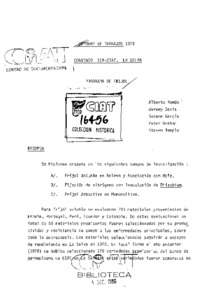Informe de trabajos 1979: Convenio ICA-CIAT: Programa de frijol
Different assays on climbing beans in relay cropping or associated with maize, N fixation and Rhizobium inoculation, and bush beans in monoculture are reported. These were conducted in La Selva, Antioquia (Colombia), through a collaborative project between the Instituto Colombiano Agropecuario (ICA) and CIAT. A total of 56 materials were selected from 723 from Spain, Portugal, Peru, Ecuador, and Colombia for productivity and disease- resistance, especially to anthracnose (Colletotrichum lindemuthianum). In a previous study, 9 large-grained var. were selected (greater than 40 g/100 seeds) with higher yields in relay cropping (greater than 1937 kg/ha) than Cargamanto, and among these, var. E 1056 (No. CIAT G 12488) is specially recommended for Colombia. Best planting densities for maize and beans in association are 30-40,000 maize plants/ha and 20-40,000 bean plants/ha pocket drilled in a 90-100 cm x 90-100 cm square planting. In trials with advanced lines up to F4 and F6, 12 were selected from an original lot of 32,680 plants yielding greater than 1631 kg/ha, the majority with black- or brown-colored seed. Four red-seeded var. (V 7916, V 7918, V 79115, and V 79116) were selected for productivity, early maturation, and resistance to major diseases. In trials of N fixation 3 strains of Rhizobium, that allowed yields similar to those obtained when treated with N fertilizer, were identified. The soil application of PCNB reduced root rot and the toxicity of Rhizobium by the fungicide decreased when the inoculum was applied in granules below the seed. (AS-CIAT)

